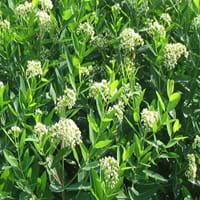Life Span
Perennial
Annual
Type
Flowering Plants
Flowering Plants, Herbs, Shrubs
Origin
Italy, Southern Europe, western Balkans
Southern Asia, India
Types
not available
Crotalaria benghalensis Lam.
Crotalaria fenestrata Sims
Crotalaria ferestrata Sims
Crotalaria porrecta Wall.
Crotalaria sericea Willd.
Crotalaria tenuifolia Roxb.
Crotalaria viminea Wall.
Number of Varieties
Not Available
Habitat
Islands, Not Available
Mountain tops, Temperate Regions, Terrestrial
USDA Hardiness Zone
7-10
8-11
AHS Heat Zone
7 - 4
12 - 4
Sunset Zone
21,22
H1, H2, 3a, 3b, 4, 5, 6, 7, 8, 9, 10, 11, 12, 13, 14, 15, 16, 17, 18, 19, 20, 21, 22, 24
Habit
Upright/Erect
Oval or Rounded
Flower Color
Lavender, Light Blue, White
Yellow, Gold
Flower Color Modifier
Bicolor
Bicolor
Fruit Color
Non Fruiting Plant
Black
Leaf Color in Spring
Green, Light Green
Light Green, Gray Green
Leaf Color in Summer
Green, Light Green
Light Green, Gray Green
Leaf Color in Fall
Green, Light Green
Light Green, Gray Green
Leaf Color in Winter
Light Green
Light Green
Leaf Shape
Compound
Ovate
Plant Season
Summer, Fall
Spring, Summer, Fall, Winter
Sunlight
Full Sun, Partial Sun
Full Sun, Partial Sun
Growth Rate
Medium
Very Fast
Type of Soil
Loam
Clay, Loam, Sand
The pH of Soil
Acidic, Neutral
Neutral
Soil Drainage
Average
Well drained
Bloom Time
Early Summer, Summer, Late Summer
Indeterminate
Tolerances
Heat Tolerance
Drought
Where to Plant?
Ground, Pot
Ground, Pot
How to Plant?
From bulbs, Seedlings, Stem Planting
Seedlings
Plant Maintenance
Low
Medium
Watering Requirements
Average Water Needs, Do Not over Water, Never Over-water, Requires regular watering
Does not require lot of watering, Requires watering in the growing season
In Summer
Lots of watering
Lots of watering
In Spring
Moderate
Moderate
In Winter
Average Water
Average Water
Soil pH
Acidic, Neutral
Neutral
Soil Type
Loam
Clay, Loam, Sandy
Soil Drainage Capacity
Average
Well drained
Sun Exposure
Full Sun, Partial Sun
Full Sun, Partial Sun
Pruning
Remove damaged leaves, Remove dead branches, Remove dead leaves, Remove dead or diseased plant parts
Cut or pinch the stems, Remove damaged leaves, Remove deadheads, Shape and thin as needed
Fertilizers
fertilize every 2-3 weeks while growing, fertilize in growing season
All-Purpose Liquid Fertilizer
Pests and Diseases
fungus
Insects, Moth, Red blotch
Plant Tolerance
Drought, Heat Tolerance
Drought
Flower Petal Number
Single
Single
Showy Foliage
Not Available
No
Foliage Texture
Not Available
Fine
Foliage Sheen
Not Available
Matte
Attracts
Birds, Insects
Not Available
Allergy
Toxic
no allergic reactions
Aesthetic Uses
Beautification, Landscape Designing, Showy Purposes
Not Used For Aesthetic Purpose
Beauty Benefits
Not Available
Not Available
Environmental Uses
Air purification
Air purification
Medicinal Uses
Asthma, Cough, Unknown
Antispasmodic, Cold, Cough, Diarrhea, Digestive disorders, Jaundice, Liver problems, Urinary tract problems, Wounds
Part of Plant Used
Flowers, Leaves
Fruits, Leaves
Other Uses
Decoration Purposes, Showy Purposes, Used as Ornamental plant
Culinary use
Used As Indoor Plant
Yes
No
Used As Outdoor Plant
Yes
Yes
Garden Design
Mixed Border, Wildflower
Edging
Botanical Name
CAMPANULA pyramidalis
Apocynum cannabinum
Common Name
Chimney Bellflower
Dogbane, milkweed, honeybloom, bitter root, black
hemp, hemp dogbane, lechuguilla, westernwall
In Hindi
Chimney Bellflower
भारतीय गांजा
In German
Schornstein Glockenblume
Indischer Hanf
In French
cheminée Bellflower
chanvre indien
In Spanish
Chimenea Bellflower
El cáñamo indio
In Greek
καμινάδα καμπανούλα
ινδική κάνναβη
In Portuguese
chaminé Bellflower
cânhamo indiano
In Polish
komin Bellflower
Konopie indyjskie
In Latin
caminorum purgatores Bellflower
Latin Hemp
Phylum
Tracheophyta
Not Available
Class
Magnoliopsida
Not Available
Family
Campanulaceae
Fabaceae
Genus
Campanula
Crotalaria
Clade
Angiosperms, Asterids, Eudicots
Angiosperms, Eudicots, Rosids
Tribe
Not Available
Crotalarieae
Subfamily
Not Available
Faboideae
Number of Species
Not Available
Importance of Chimney Bellflower and Indian Hemp
Want to have the most appropriate plant for your garden? You might want to know the importance of Chimney Bellflower and Indian Hemp. Basically, these two plants vary in many aspects. Compare Chimney Bellflower and Indian Hemp as they differ in many characteristics such as their life, care, benefits, facts, etc. Every gardener must at least have the slightest clue about the plants he wants to plant in his garden. Compare their benefits, which differ in many ways like facts and uses. The medicinal use of Chimney Bellflower is Asthma, Cough and Unknown whereas of Indian Hemp is Antispasmodic, Cold, Cough, Diarrhea, Digestive disorders, Jaundice, Liver problems, Urinary tract problems and Wounds. Chimney Bellflower has beauty benefits as follows: Not Available while Indian Hemp has beauty benefits as follows: Not Available.
Compare Facts of Chimney Bellflower vs Indian Hemp
How to choose the best garden plant for your garden depending upon its facts? Here garden plant comparison will help you to solve this query. Compare the facts of Chimney Bellflower vs Indian Hemp and know which one to choose. As garden plants have benefits and other uses, allergy is also a major drawback of plants for some people. Allergic reactions of Chimney Bellflower are Toxic whereas of Indian Hemp have no allergic reactions respectively. Having a fruit bearing plant in your garden can be a plus point of your garden. Chimney Bellflower has no showy fruits and Indian Hemp has no showy fruits. Also Chimney Bellflower is not flowering and Indian Hemp is not flowering . You can compare Chimney Bellflower and Indian Hemp facts and facts of other plants too.





